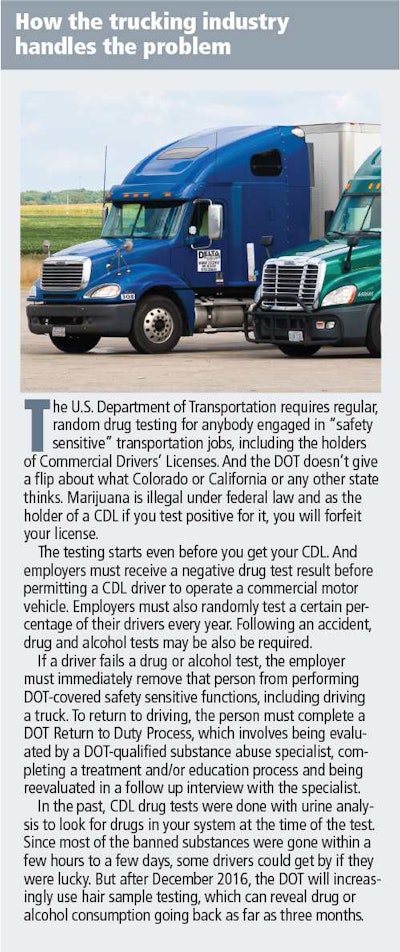
There is a story still told in the Savannah, Georgia, business community about the time equipment manufacturer JCB held a job fair for prospective employees. When the eager prospects assembled in the company’s new glass foyer were informed that drug testing would be required before they were hired, half of them left.
JCB’s corporate zero-tolerance policy may have made it harder to fill job openings, but there’s no doubt it saved them from huge problems later and resulted in a more productive, stable and healthy workforce.
Last month, we detailed all the problems this country’s drug and substance abuse epidemic has brought to the construction industry. In Part II this month, we will focus on solutions: things you can do as a construction company owner or manager to keep the debilitating influence of drugs from hurting your company and endangering your employees. We’ll also bring you up to date on the legal issues regarding legalized marijuana and how those may affect contractors who want to maintain a drug-free workplace.
SAVING LIVES, SAVING MONEY
The most important thing you can do to keep drug and alcohol abuse out of your company is to create a drug-free workplace with a written policy, regular testing, sanctions for abusers and training for all your people.

• Turfscape Landscape Care, Chandler Arizona, saved more than $50,000 a year thanks to increased productivity, fewer accidents, and reduced absenteeism and turnover.
• W.W. Gay Mechanical Contractors of Florida saved $100,000 on worker’s comp premiums, and experienced increased productivity, reduced absenteeism and fewer accidents.
• Warner Corporation, Washington D.C., saved $385,000 in one year by establishing a drug-free workplace program that included employee assistance programs (EAPs). The savings came from lower workers’ comp rates, lower vehicle insurance and a reduction in the number of accidents.
Currently 13 states offer a discount on worker compensation insurance to employers that maintain a drug-free workplace program. These are: Alabama, Arkansas, Florida, Georgia, Hawaii, Idaho, Kentucky, Mississippi, Ohio, New York, South Carolina, Tennessee and Virginia. Most offer a 5 percent discount, but Georgia offers 7.5 percent, New York offers a maximum credit that can go up to 10 percent the first year, and reductions in Ohio can rise as high as 20 percent.
Additionally, many states require a drug-free workplace program for contractors wishing to bid on state or public works projects, including Delaware, Georgia (for contracts more than $25,000), Idaho, Indiana, Illinois, Tennessee (drug-free workplace information must be included in all construction bid documents), South Carolina (contractors with more than $50,000 in annual revenues) and Virginia. There’s even a Florida law that states: “Where two or more bids of equal merit are submitted to win a contract, there is preference given to the business with drug-free workplace programs.”
And many states’ worker’s comp programs will deny or reduce medical benefits or indemnity incurred in an accident when the drug or alcohol impairment can be proven to be a contributing cause to the accident.
HOW TO ESTABLISH A DRUG-FREE WORKPLACE
Studies show injury rates decline significantly for construction firms that implement drug testing for employees. Doing so brings you an immediate safety benefit.

• Your written policy must be reviewed by all employees who sign and date the policy after reading it.
• Before being hired, job applicants and new hires should be informed of the company policy regarding drugs and alcohol.
• All new employees should be given a drug test before they’re hired.
• Drug testing should be conducted periodically and unannounced using a random sample of employees. Be sure to include all employees, including executives, managers and office staff. There are drug testing firms that can handle all of this for you, including randomizing the sample. As these vary, check your state laws on the details of testing.
• Educate and train supervisors on how to detect substance abuse in their crews. Pre-work stretching sessions and safety talks are a good way for managers to ensure crew members are sober and fit for work.
• If you have a reasonable suspicion that a worker is impaired due to substance abuse, have them tested. Ensure that your substance abuse policy clearly defines what behavior justifies drug or alcohol testing.
• If you suspect substance abuse has contributed to an accident, test the person responsible immediately after the incident. But be cognizant of the OSHA rules regarding this. See the “New OSHA post-accident drug test rule” section on page 47.
• If a person tests positive for drug or alcohol impairment on the job, take the punitive actions spelled out in your policy.
• If your policy allows for a return to work after a period of rehabilitation, test that person soon after they return.
• Establish an employee assistance program (EAP) to help employees manage their personal and work lives with the goal of healthy outcomes and without the need for drugs or alcohol. The average annual cost per employee for an EAP program is around $25.
• Re-invigorate your safety program and look at ways to reduce the kinds of accidents and injuries that may require your workers to get opioid or pain medications from a doctor.
Note that drug testing laws vary considerably by state, and you need to follow the state law to the letter. You may also want to seek the advice of a qualified lawyer or human resources specialist as well. For a complete look at the state laws see the article: “50 State Survey: Drug-Free Workplace Programs” in our online resource sidebar at the end of this article.
Current laws on marijuana and the workplace
Don’t think for a minute that marijuana is of little concern to the construction industry. It is a major threat to health and safety. Nine percent of all users develop addiction to this drug, and more Americans obtain treatment for marijuana than any other drug. For regular users, some level of impairment can last for days – in other words, long past the weekend party. In studies on tasks related to driving, it’s been shown that chronic marijuana smokers exhibit symptoms of impairment for at least three weeks after use.
In the lawsuit Coats v. Dish Network, Brandon Coats, a Colorado-based employee of Dish Network was fired after testing positive for marijuana use, even though Coats was using marijuana legally for medical purposes in his off-duty hours. In June, 2015, the Colorado Supreme Court upheld Dish Network’s right to fire Coats, saying the company had a constitutional right to enforce a drug-free workplace policy.
According to the AGC, all the state courts that have addressed the issue – including California, Montana, Oregon and Washington – have upheld the right of employers to have drug-free workplace policies. But then it gets sticky.
Seven states – Arizona, Connecticut, Delaware, Illinois, Maine, Nevada and Rhode Island – have laws that protect employees from job-related penalties for marijuana use. Right now, no courts have confronted this conflict, but if they do, a ruling that allows employees to use marijuana legally in their off hours would have dramatically disruptive effects on the construction industry.
Until some clarity on this issue is determined by the courts, the authors of Workplace Drug Testing in the Age of Legal Marijuana (see resources at the end of this article) recommend what they call a “per se” zero tolerance policy. A per se policy is not based on impairment but is rather a blanket rule of zero tolerance that applies to everybody in the company at all times without the necessity of showing impairment before testing.
New OSHA post-accident drug test rule
In August 2016, another wrinkle emerged in the substance abuse testing world. OSHA issued a new rule [Regulation 1904.35(b)(1)(iv)] requiring companies to have a reasonable procedure for employees to report work-related injuries and illnesses, and not to discriminate or retaliate against those who do.
OSHA simply wanted employees to feel free to report injuries and accidents, but in the ruling the agency also said: “Blanket post-injury drug testing policies deter proper reporting,” and thus could be considered discrimination or retaliation and subject to OSHA citation. But OSHA also said it would permit post-accident drug testing if there were a reasonable possibility that drug use contributed to the injury or illness, as long as the testing complied with state or federal laws or regulations.
In other words, if OSHA thinks you’re keeping your workers from reporting accidents or illness by threatening them with widespread drug testing, they may yank your chain.
More from OSHA: “Although drug testing of employees may be a reasonable workplace policy in some situations, it is often perceived as an invasion of privacy, so if any injury or illness is very unlikely to have been caused by employee drug use, or if the method of drug testing does not identify impairment but only use at some time in the recent past, requiring the employee to be drug tested may inappropriately deter reporting.”
So now post-incident substance abuse testing should be limited to situations in which employees’ drug use is likely to have contributed to the incident, and for which the drug test can accurately identify impairment caused by drug use. This rule will have no effect on regular, random drug testing as part of your state-sanctioned drug-free workplace program. And if you have CDL drivers in commercial trucks, you can continue to test these employees as required by state or federal laws because those tests are mandatory and not considered discriminatory.
Note that failure to follow these guidelines could result in OSHA fines up to $12,000 per violation and $120,000 for willful or repeat violations.
All of this is contained in OSHA’s final interpretation of its final rule on electronic reporting of workplace injuries and illnesses. (https://www.federalregister.gov/documents/2016/05/12/2016-10443/improve-tracking-of-workplace-injuries-and-illnesses#p-547)
Online resources:
• 50 State Survey: Drug-Free Workplace Programs.
A searchable online list of all the state laws regarding drug-free workplace requirements and Worker’s Comp regulations. Google: “50 state survey: Drug free workplace programs.”
• National Drug-Free Workplace Alliance
A compendium of information, services and resources you can use to create a drug and alcohol free workplace and stay on top of these issues and changes in the law. www.ndwa.org/index.php
• Drug-free Workplace Toolkit
A printable PDF that contains everything you need to know about starting your own drug-free workplace program, EAPs and testing requirements. Google: “Drug Free Workplace Toolkit”
• Best Practices for Random DOT Drug and Alcohol Testing www.transportation.gov/odapc/best-practices-dot-random-drug-and-alcohol-testing
• Quest diagnostics
Quest is in the business of selling drug testing kits, but their Drug Screening Knowledge Center website has lots of information on not only testing, but EAPs, drug-free programs and insurance issues. www.questdiagnostics.com
• Workplace Drug Testing in the Era of Legal Marijuana
This white paper, produced by the Institute for Behavior and Health, will give you a clear and detailed explanation of how workplace drug testing and rules have changed in the era of increasing marijuana legalization.
www.drugfreebusiness.org/Media/documents/IBH_workplacetesting.pdf














